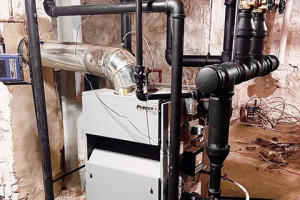
Hello, old friend. I’m writing today to say thanks, and to say farewell. This will be my last column.

Life nowadays is often confusing. What, between unisex, White House scandals, New Age philosophies, the collapse of the Soviet Empire along with the New York Rangers, it’s tough to tell whether we’re coming or going anymore. With that in mind, I’d like to offer you some clarity on a particular issue I’ve studied for years. Hopefully, this will help you to understand the differences between the species, Homo Engineerium and Homo Contractium. Here goes.
If an engineer takes the train to work, he is likely to keep track of the miles traveled and the time elapsed between each station. He will keep these records for years in spiral notebooks and drive people crazy by sharing this useless drivel with them at a moment’s notice. Contractors are different. Contractors rarely take trains. They take trucks instead. Big mechanical contractors take limousines and sit in the back.
An engineer is likely to say things such as, “Particulates of iron-oxide residue.” A contractor, when asked to explain this same natural occurrence, will say, simply, “rust.” Engineers subscribe to the Charles Dickens School of Writing, believing that the volume of their words will signify the value of their work. Contractors talk like daytime TV people – Jerry Springer to be exact.
Engineers wear rumpled suits. Contractors wear chinos and open-collar shirts, except for when they go to Atlantic City or Las Vegas. When at those place they will add gold chains to their chinos and open-collar shirts. This also applies to females in both professions, of course.
If Madonna pulled up to a stop light next to a male engineer, rolled down her window and gave the guy a smile you could pour on a pancake, the engineer would ask her how many cubic inches her car’s engine had. A male contractor, under the same circumstances, would be rifling through his glove compartment, looking for gold chains.
An engineer will often have letters after his name on his business cards – BS, MS, Ph.D., PE, and whatnot. A contractor will look at these letters and decide that this particular engineer has absolutely no knowledge of the real world. The more letters there are, the stronger the contractor’s conviction will be.
An engineer will hang his many diplomas over his desk. A contractor will hang a photograph of the Little League team his company sponsored last summer and feel just as proud.
An engineer will often look around a boiler room, desperately trying to find the boiler, which he or she perceives to be a small, square, blue box with the block-letters, BOILER, written across it. A contractor will sometimes hold the blueprints upside-down and, not realizing they are indeed upside-down, proceed to install the boiler on the ceiling. Hey, what the engineer wants, the engineer gets!
At lunch, engineers will order ice tea. Contractors will order beer.
Engineers carry electronic organizers containing the phone numbers, addresses, and other vital statistics of everyone they’ve ever met in their entire lives. They will spend years tapping this information into that thin, black box.
Contractors have the same information, but they keep it on hundreds of Post-It® notes stuck to the visors and dashboards of their trucks. Big mechanical contractors don’t bother with any of this information because they’re not going to call you back anyway.
Engineers wear those watches with the calculators built into them. They tap at them nonstop with the tips of their Cross pens and pencils. Contractors wear Rolexes and flash them in your face as much as possible.
Engineers watch A&E. Contractors watch ESPN.
Engineers and contractors both stare at the architects, wondering what the heck is going on in those wacky heads.
Engineers and contractors both love traditional design methods, but for different reasons. Engineers love traditional methods because it means they can just keep using the standard specifications they’ve had in their file cabinets since 1955. Contractors love tradition because it means they don’t have to take time from their busy schedule to learn anything new. When it comes to hydronic-system design, both groups believe that 1955 was a very good year!
Engineers think manufacturers reps are good guys because the reps give the engineers free catalogs filled with color pictures of the latest products, not that the engineers are planning to do anything with those catalogs. They just think the catalogs look cool up there on the shelf! Contractors also think manufacturers reps are wonderful because reps are so easy to abuse.
Engineers attend the ASHRAE conventions, wait on long lines for taxis, pay exorbitant amounts of money for hot dogs and ice tea, and actually attend the meetings. Contractors attend the PHCC and MCA conventions, wait on shorter lines for taxis, skip the hot dogs, grab as many free brewskis as possible, and look for the nudie bars.
Engineers write letters to the editors of trade journals. The editors have no idea what the engineers are talking about because the letters read like this, “#@!$%^&*=1,253. So there!” Needless to say, all these letters get published exactly as is. Contractors write letters to the editors of trade journals that read like this: “I luv yur magazoon. Dont never chang!” Editors zealously edit these letters, feeling smug and superior all the while – even though they can’t figure out how the heating systems in their own homes work.
Engineers carry in their leather briefcases those big Swiss Army knives with all the attachments. They will never actually use these, but they’re content knowing that they’re prepared. Contractors carry Leatherman tools on their belts and use them much too frequently to disassemble anything that’s looks even remotely mechanical.
A contractor will test a high-voltage circuit with the tips of his wet fingers and be honestly surprised when he gets thrown across the room by the hot, blue light (Hey, it worked the last time!). An engineer will write a 50,000-word specification granting authority (in the contractor’s mind) to do basically the same thing, but only after the contractor submits suitable OSHA documentation as to the projected angle of his body’s intended flight and terminal velocity.
An engineer will look at the Leaning Tower of Pisa and come up with ways to straighten it out. A contractor will look at the Leaning Tower and figure out how many extras he’s entitled to.
As children, engineers collected baseball cards and memorized the players’ statistics. As children, contractors used those same cards to gamble.
A contractor goes to the theater and spends the night speculating on how he would heat this place. An engineer will sit down in the same theater and, knowing how it’s heated, set out to calculate the load in order to prove that the design engineer was wrong.
After reading an article about antifreeze in hydronic radiant heating systems a contractor might send the author a note, thanking him for the information. An engineer will send the author a 5,000-word letter, chastising him for failing to mention in the article that antifreeze is also required in any Antarctic snowmelt application. How dare he overlook such an important detail! Doesn’t he realize the damage he’s bound to cause by such an oversight? And what of his editor? Shouldn’t she have caught this glaring error as well? Shame, shame!
If you’re on a buffet line behind a group of engineers it will take you a very long time to get your sandwich because engineers are the most precise sandwich makers you will ever find. They don’t make a sandwich; they build a sandwich. The meat must align with the cheese, and the tomatoes can’t overlap the crust by more than a millimeter. Engineers are also expert at the mustard/mayo smear. Nothing ever drips. The sandwich specs are exact. Contractors on a buffet line? Those guys just eat as they go, wiping their mouths on their sleeves, smiling a lot, and belching.
Engineers will write me nasty letters about this column. Contractors probably won’t even read it because they’re too busy trying to get around the plans and specs.
I live my life between these groups - belonging to neither, but loving them both – and I hope this clears things up for you.

Hello, old friend. I’m writing today to say thanks, and to say farewell. This will be my last column.

My six-year-old grandboy, Brendan, was in the vestibule of the diner when the bubblegum machine caught his attention. It was one of those spiral models that appeared in t...

Subdural posed a question on The Wall at HeatingHelp.com in the Strictly Steam section, where some of the sharpest knives in the drawer post every day. The question was a...